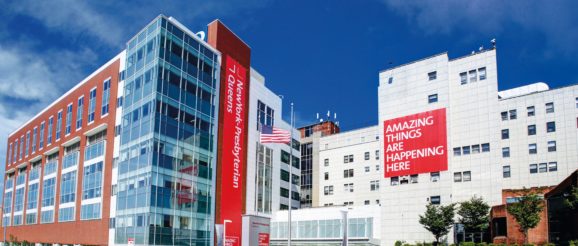Why NewYork-Presbyterian launched its new Hauser Institute for Health Innovation

PHOENIX—Three years ago, a NewYork-Presbyterian emergency room physician approached the health system’s chief information officer with an idea to do virtual ER visits for patients with less severe medical issues.
It wasn’t a foregone conclusion that it would work or that it could scale. There was no initial business plan. But Daniel Barchi, NewYork-Presbyterian’s CIO, thought it was an idea worth testing out.
“I said ‘Let’s try it in two weeks.’ We took technologies that we had and we made things work,” he said.
“The first patient came in and the next day we did another one. As we saw more patients, we learned more and tweaked the system. We got up to 50 and we saw that it worked. It’s efficient, patients like it and they are in and out in 35 minutes,” Barchi said, speaking during the CHIME Fall CIO Forum this week.
That service has scaled into the health system’s Express Care telehealth program, an example of how the health system has sought to embrace what Silicon Valley refers to as “failing fast” in an attempt to get to innovations more quickly.
It was also a major step toward what would be called the Hauser Institute for Health Innovation, which launched in July with specific focus on expanding telehealth services including remote patient monitoring and teleparamedics. NewYork-Presbyterian, based in New York City, is an 11-hospital system that experiences 2.6 million patient visits annually.
The health system serves a large, broad population, Barchi said, including parts of New York City where populations have historically been underserved by healthcare. The health system has been scaling up telehealth services and seen success with leveraging virtual care tools to provide efficient remote care.
A key focus of the new Hauser Institute will be expanding telemedicine services deeper into local communities with an emphasis on preventive health and wellness, according to the health system.
“NewYork-Presbyterian is using advanced technologies to fundamentally change the way that health care is provided, making it more convenient and accessible to all,” philanthropist Rita Hauser said in a statement. Rita and Gustave Hauser gave more than $50 million to NewYork-Presbyterian in support of the hospital’s comprehensive telehealth services.
The Hausers’ financial support also helped NewYork-Presbyterian expand its fleet of mobile stroke treatment units with advanced telemedicine technology to allow neurologists from hospital locations to be consulted remotely.
Virtual visits help level disparities among different patient populations, particularly for patients who don’t know how to navigate the health system or have language barriers, according to Barchi. “We’re using technology to get through barriers, whether it’s time, language or transportation, to serve all of our patients,” he said.
The organization launched NYP OnDemand three years ago as a comprehensive suite of digital health services, and that has grown to more than 46 programs. NYP OnDemand services enable patients to connect with healthcare providers via the hospital’s website and mobile apps as well as self-service kiosks at some Walgreens and Duane Reade stores. The services include digital urgent care, where patients can access emergency medicine physicians through a live video chat; peer-to-peer consults between physicians; and digital second opinions, which enable patients to contact specialists via a portal with no need for in-person appointments.
Through NYP OnDemand, the health system has now conducted 500,000 telehealth visits, Barchi said.
Leveraging AI and automation
The health system has moved forward to leverage advanced technologies like autonomous robots, artificial intelligence and robotic process automation.
NewYork-Presbyterian uses robots inside the hospitals for logistics and room service delivery of patient meals. With many of these technology initiatives, the technology itself is not the biggest challenge but often the interfaces, Barchi noted. “The most challenging part of this is to make the 2019 robots talk to the 1982 elevators,” he said. “I believe healthcare technology is 80% people, 15% process, and 5% technology.”
The health system also is taking steps to utilize artificial intelligence to improve clinical decision-making. As one example, the health system developed AI-driven clinical recommendation text messages sent to physicians to help drive down patients’ length of stay.
“We applied an AI system that looked through thousands of patient records and started learning, how does a patient go home effectively? The system isn’t telling doctors what to do, but it’s nudging them and helping them to make decisions that they were likely going to make anyway, like ordering physical therapy,” he said.
NewYork-Presbyterian also is leveraging AI for back-end healthcare operations, such as clinical appeals optimization, to improve efficiency and reduce costs, he said. Through AI and advanced coding, the health system expects to save $10 million to $11 million this year.
The health system also began using AI-powered chatbots on its website for patient-facing services such as matching patients to a doctor or providing directions to a hospital. “AI can operate on the front end to answer about 40% of questions. We can allow voice recognition and AI to help get people to the right spot in our hospital,” Barchi said.
The health system also is using robotic process automation (RPA) to automate tasks such as staff timekeeping, insurance verification and claims denial follow-ups. A manual task that typically took 10 minutes can be accomplished in one minute using RPA technology, Barchi said.
“We can hire people to do higher-level work and let RPA do the skunk work,” he said.
There are ongoing debates about the impact of AI and automation on the healthcare workforce, but Barchi said concerns that technology will replace jobs are overblown. “AI won’t replace managers, but managers who use AI will replace those who don’t,” he said.
